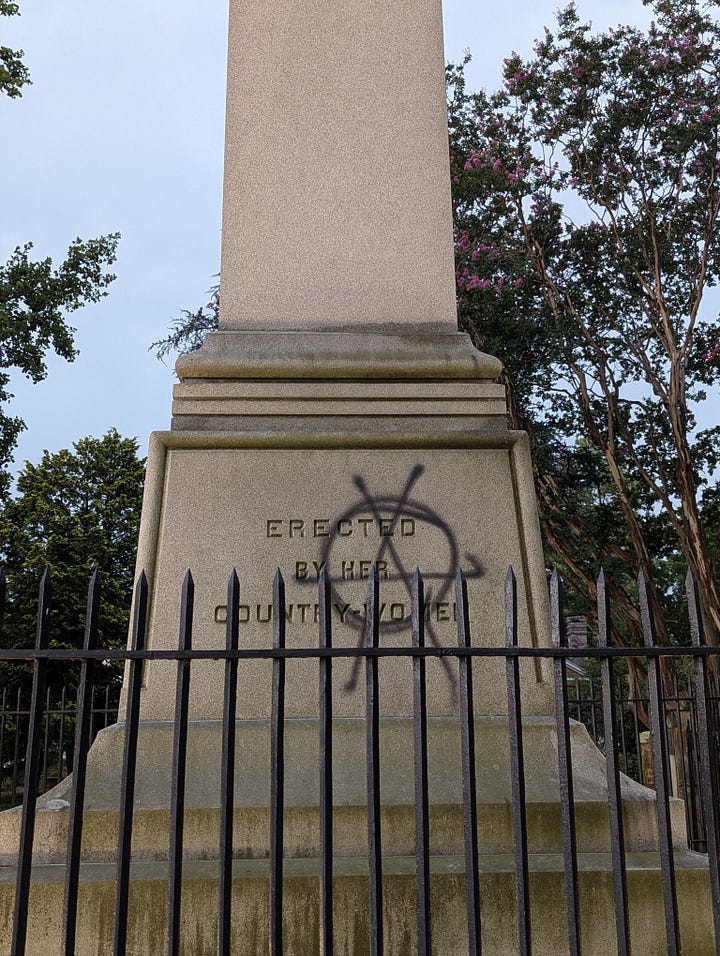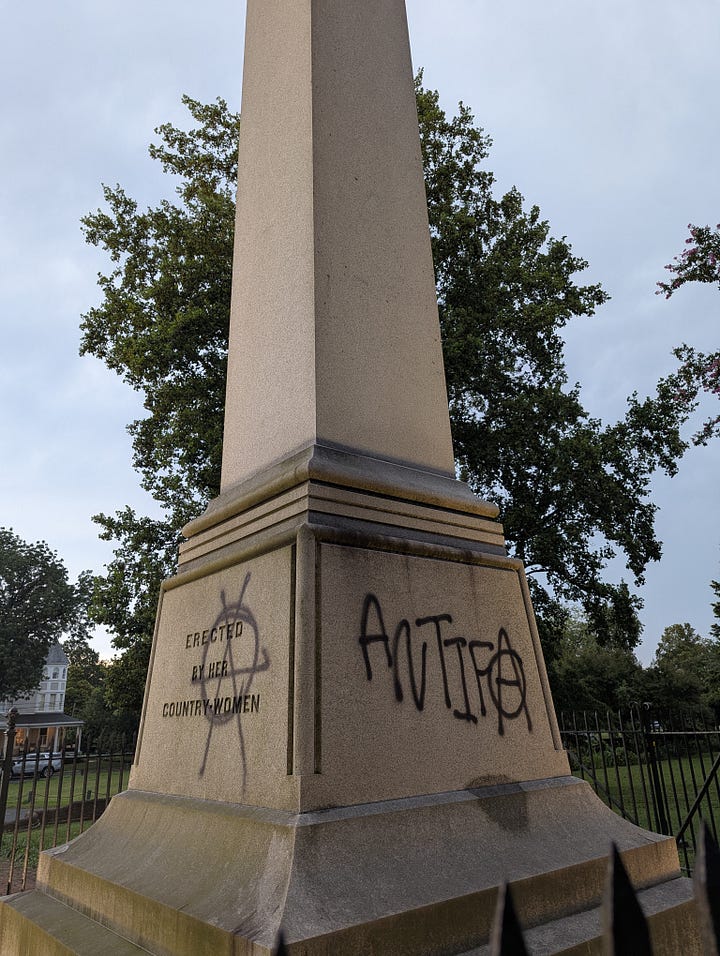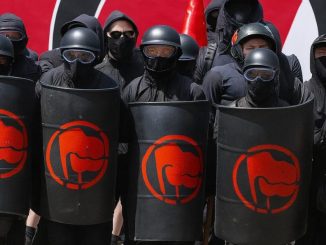
| Published July 30, 2025
📰 What Happened
On or around July 29, 2025, vandals allegedly defaced the Mary Washington Monument in Fredericksburg, Virginia—a site dedicated to the mother of George Washington—with spray-painted graffiti bearing the word “ANTIFA” and an accompanying symbol commonly associated with the group.
Photos circulated by The Gateway Pundit show red spray paint across the monument’s base, sparking immediate outrage among conservative commentators and heritage preservation groups. The vandalism has been described as a deliberate act of political provocation and historical desecration, with critics calling it a “new low” in culture war tactics.
Local authorities were alerted, and an investigation is now underway. Police have not yet identified any suspects or verified who was behind the graffiti. As of now, there has been no direct claim of responsibility from Antifa-affiliated groups, and no official statement from law enforcement tying the act definitively to Antifa activists.
The nonprofit Friends of the Washington Heritage Museums, which helps care for the site, has publicly condemned the act and is offering a $1,500 reward for information leading to the identification and arrest of those responsible.
Community members and historical preservation advocates have also weighed in, expressing disappointment and concern over what they view as growing disrespect for American heritage sites, especially those connected to the founding generation.
Despite the damage, the monument is expected to be restored, though cleanup and restoration costs could be significant depending on how deep the spray paint penetrated the stonework.
🏛 Background on the Monument
The Mary Washington Monument in Fredericksburg, Virginia, honors Mary Ball Washington, the mother of George Washington. She is often remembered for her resilience, strong moral character, and significant influence on her son’s upbringing. The monument marks her final resting place near Kenmore, the estate of her daughter Betty Washington Lewis.
The effort to honor Mary Washington began in the early 19th century. Construction started in 1833, but due to funding issues and the Panic of 1837, it was left unfinished for decades. It wasn’t until the 1880s—thanks to renewed interest led by women’s patriotic organizations like the National Society of the Daughters of the American Revolution—that work resumed.
The monument was completed in 1894, becoming one of the first major memorials in the U.S. erected by women to honor a woman. It reflects both the reverence Americans held for George Washington’s mother and the increasing role women were beginning to play in public and historical commemoration during the late 19th century.
Today, the monument is part of the Washington Heritage Museums and remains a symbol of maternal legacy, early American values, and historic civic pride.


 Implications:
Implications:
The alleged defacement of the Mary Washington Monument carries several implications, both symbolic and societal:
1. Cultural Flashpoint in the Ongoing Culture War
The alleged defacement of the Mary Washington Monument represents more than just vandalism—it taps directly into the deepening culture war in the United States. Over the past decade, historical statues and memorials have increasingly become battlegrounds for ideological conflict, especially as activist groups challenge long-standing national narratives tied to the Founding Fathers, colonialism, and perceived systems of oppression.
What makes this case particularly inflammatory is that Mary Washington herself was not a military figure, political leader, or slaveholder, but rather the mother of George Washington. This broadens the scope of cultural targets and suggests a shift from challenging specific controversial figures to challenging symbols of the American founding as a whole.
For traditionalists and many average Americans, this act may feel like an attack not just on a monument, but on shared national heritage and respect for family, motherhood, and early American values. On the other side, radical activists may view any monument tied to the founding era as fair game for protest—regardless of the individual it honors—because of its association with systemic injustice.
This polarization has the potential to inflame tensions further, reinforcing perceptions that one side wants to preserve American history, while the other seeks to erase or rewrite it. In that sense, the vandalism becomes not just a local act of destruction, but part of a much larger national narrative of cultural division
2. Threat to Historical Preservation
The defacement of the Mary Washington Monument serves as a stark reminder of how vulnerable historical landmarks have become—even those with little or no political controversy attached to them. Mary Ball Washington is remembered primarily for her role as the mother of the nation’s first president, not for involvement in war, politics, or slavery. The fact that her monument was targeted suggests a troubling shift where any association with America’s founding era may now make a site a target.
This poses a broader risk to historical preservation efforts across the country. Many communities rely on local fundraising, nonprofit stewardship, and public goodwill to maintain centuries-old monuments. Acts of politically motivated vandalism can lead to not only physical damage but also discouragement among donors and volunteers who dedicate themselves to preserving these landmarks.
Additionally, repeated attacks on monuments could pressure cities and heritage groups to divert limited funds toward security measures—surveillance cameras, fencing, lighting—rather than historical education, restoration, or guided tours. This undermines the educational and cultural mission of these sites.
In the long term, a climate where any monument is seen as fair game for destruction could accelerate the erosion of historical memory, especially among younger generations. Once a monument is vandalized, restored, or removed entirely, the historical dialogue surrounding that figure or era often fades, replaced by political rhetoric rather than public education.
3. Potential for Political Blowback
If the vandalism is officially linked to Antifa or another far-left group, the incident is likely to become a powerful political talking point—especially for conservative leaders, commentators, and candidates heading into the 2025 election season. While Antifa is not a centralized organization, its name and symbolism are often invoked by critics as a representation of radical, lawless activism. Even the perception that Antifa was involved can be enough to ignite outrage among conservative voters and drive calls for action.
This incident could be used to reinforce narratives about the erosion of national values, the left’s alleged disregard for American history, and a broader attack on traditional institutions. Already, some media outlets and influencers are referring to the act as a “new low,” suggesting it crosses an emotional and symbolic threshold—defacing a monument not just to any historical figure, but to the mother of the nation’s first president.
In response, we may see renewed efforts to pass state-level laws increasing penalties for defacing historical monuments, as well as proposals to federally protect “founding-era” landmarks from politically motivated acts of vandalism. At the same time, critics of such legislation may argue it threatens free expression or diverts resources from more pressing community needs.
Overall, the act—if confirmed and widely publicized—could deepen political divisions, motivate voters on the right, and become a wedge issue in local and national races, particularly in swing states and regions where cultural identity plays a strong role in political affiliation.
4. Security Concerns for Public Memorials
The vandalism of the Mary Washington Monument underscores growing concerns about the security of public memorials, particularly those that are unguarded, lightly funded, or located in open-access areas. Many historical sites—especially older ones—were designed to be publicly accessible and aesthetically integrated into the community, not fortified against ideological attacks.
This latest incident may compel municipalities, preservation societies, and even state governments to reassess their approach to monument security. That could mean installing surveillance cameras, motion-detection lighting, or even fencing around sites once considered immune to controversy. In urban areas, it might include partnerships with local law enforcement for routine patrols. All of these measures, however, come with a significant financial and logistical burden, particularly for small cities or nonprofit organizations that already operate on limited budgets.
The long-term consequence is a shift in how Americans interact with their historical landmarks. Where once people could freely walk up, read inscriptions, and reflect, future generations may find such sites guarded, distanced, or locked behind barriers—fundamentally altering the public and educational value of these memorials.
Moreover, this raises a policy question: who is responsible for protecting these symbols of history? Is it the duty of local government, national heritage institutions, or private donors? Without a clear answer, some monuments may fall through the cracks, left vulnerable to politically charged defacement and neglect.
 Overall Takeaway:
Overall Takeaway:
The alleged defacement of the Mary Washington Monument may seem like an isolated act of vandalism, but its implications ripple far beyond a single city or statue. It strikes at the heart of America’s ongoing struggle over how its history is remembered, honored, and debated. Targeting a monument to George Washington’s mother — a figure with no known political controversy — suggests that even the most foundational, non-political symbols of American heritage are no longer immune from the fallout of modern ideological battles.
Whether or not the act is officially linked to Antifa, the symbolism is potent enough to energize political discourse, reignite calls for stronger monument protections, and deepen the nation’s cultural divide. It also poses serious questions about how society balances free expression, public safety, historical memory, and civic unity.
In a time where monuments are being increasingly politicized, the Mary Washington case reminds us that history, once thought to be a unifying narrative, is now a contested battleground — and the consequences are being etched in spray paint on the stones of America’s past.




